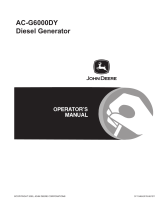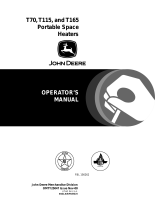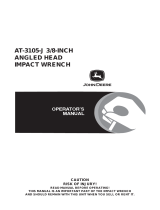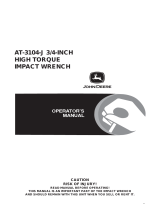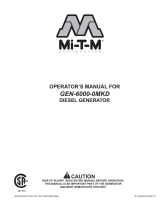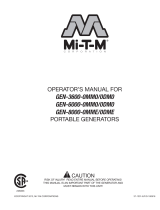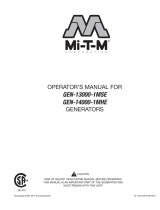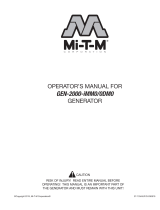Page is loading ...

Operator’s Manual 1
PR-G3200M, PR-G5500M AND
PR-G7500M
GENERATORS

2 Operator’s Manual
INTRODUCTION
THANK YOU for purchasing a John Deere product.
READ THIS MANUAL carefully to learn how to operate
and service your machine correctly. Failure to do so
could result in personal injury or equipment damage. This
manual and safety signs on your machine may also be
available in other languages. (See your John Deere dealer
to order.)
THIS MANUAL SHOULD BE CONSIDERED a permanent
part of your machine and should remain with the machine
when you sell it.
MEASUREMENTS in this manual are given in both metric
and customary U.S. unit equivalents. Use only correct
replacement parts and fasteners. Metric and inch fasten-
ers may require a specic metric or inch wrench.
RIGHT HAND AND LEFT HAND sides are determined by
facing the motor end of the machine.
The SERIAL NUMBER is located in the Specication or
Identication Numbers section. Accurately record all
the numbers to help in tracing the machine should it be
stolen. Your dealer also needs these numbers when you
order parts. File the identication numbers in a secure
place off the machine.
WARRANTY is provided from your John Deere dealer for
customers who operate and maintain their equipment as
described in this manual. The warranty is explained on
the warranty certicate shown in this manual.
This warranty provides you the assurance that your
dealer will back products where defects appear within
the warranty period. Should the equipment be abused,
or modied to change its performance beyond the origi-
nal factory specications, the warranty will become void.
Warning: This product contains lead, a
chemical known to the State of California
to cause birth defects or other reproductive
harm.
Wash your hands after handling this product.
PROTECT YOUR INVESTMENT......
Use only John Deere Fuel Protect
Fuel Stabilizer with Ethanol Protection
TY27534 or TY27535. Developed to
ensure Optimum Performance and
Protection.
IMPORTANT...Use Year Round!
34-1904 012011

Operator’s Manual 3
CONTENTS
ALL INFORMATION, ILLUSTRATIONS AND SPECIFICATIONS IN THIS MANUAL ARE BASED
ON THE LATEST INFORMATION AVAILABLE AT THE TIME OF PUBLICATION. THE RIGHT IS
RESERVED TO MAKE CHANGES AT ANY TIME WITHOUT NOTICE.
Page
Safety ............................................................ 4
Safety Signs .................................................. 5
Controls ......................................................12
Preparing the Generator .............................. 11
Operation ..................................................... 16
Troubleshooting ...........................................19
Service ......................................................... 20
Storage ........................................................25
Specications ..............................................26
Accessoires ................................................... 27
Warranty .......................................................28

4 Operator’s Manual
W
A
R
N
I
N
G
W
A
R
N
I
N
G
S
I
N
TH
E
M
A
N
U
A
L
S
.
W
A
R
N
I
N
G
S
I
N
TH
E
M
A
N
U
A
L
S
.
C
A
U
T
I
O
N
O
CAU
T
I
O
N
S
I
N
O
T
H
E
M
A
N
U
A
L
S
O
CAU
T
I
O
N
S
I
N
O
T
H
E
M
A
N
U
A
L
S
O
CAU
T
I
O
N
S
I
N
O
T
H
E
M
A
N
U
A
L
S
O
CAU
T
I
O
N
S
I
N
O
T
H
E
M
A
N
U
A
L
S
SAFETY
RECOGNIZE SAFETY INFORMATION
This is the safety alert symbol. When you see this sym-
bol on your machine or in this manual, be alert to the
potential for personal injury.
Follow recommended precautions and safe operating
practices.
UNDERSTAND SIGNAL WORDS
A signal word--DANGER, WARNING or CAUTION--is
used with the safety-alert symbol. DANGER identies
the most serious hazards.
DANGER or WARNING safety signs are located near
specic hazards. General precautions are listed on
CAUTION safety signs. CAUTION also calls attention to
safety messages in this manual.
FOLLOW SAFETY INSTRUCTIONS
Carefully read all safety messages in this manual and
safety signs on your machine. Keep safety signs in good
condition. Replace missing or damaged safety signs.
Be sure new equipment components and repair parts in-
clude the current safety signs. Replacement safety signs
are available from your John Deere Customer Service
Representative.
Learn how to operate the machine and how to use con-
trols properly. Do not let anyone operate without instruc-
tion.
Keep your machine in proper working condition. Unau-
thorized modications to the machine may impair the
function and/or safety and affect machine life.
If you do not understand any part of this manual and
need assistance, contact your John Deere Customer
Service Representative.

Operator’s Manual 5
CARBON MONOXIDE - POISONOUS GAS
Use generator outdoors, away from open windows, vents, or
doors.
Generator exhaust contains carbon monoxide - a poisonous gas
that can kill you. You CAN NOT smell or see this gas.
Never use a generator in enclosed or partially-enclosed spaces.
Generators can produce high levels of carbon monoxide very
quickly. When you use a portable generator, remember that you
cannot smell or see carbon monoxide. Even if you can’t smell
exhaust fumes, you may still be exposed to carbon monoxide.
If you start to feel sick, dizzy, or weak while using a generator, get
to fresh air RIGHT AWAY. DO NOT DELAY. The carbon monoxide
from generators can rapidly lead to full incapacitation and death.
If you experience serious symptoms, get medical attention im-
mediately. Inform medical staff that carbon monoxide poisoning
is suspected. If you experienced symptoms while indoors, have
someone call the re department to determine when it is safe to
re-enter the building.
Never operate the generator in an explosive atmosphere, near
combustible materials or where ventilation is not sufcient to carry
away exhaust fumes. Exhaust fumes can cause serious injury or
death.
NEVER use a generator indoors, including in homes, garages,
basements, crawl spaces, and other enclosed or partially-en-
closed areas, even with ventilation. Opening doors and windows
or using fans will not prevent carbon monoxide build-up in the
home.
Follow the instructions that come with your generator. Locate
the unit outdoors and away from doors, windows, and vents that
could allow the carbon monoxide gas to come indoors.
ONLY run generator outdoors and away from air intakes.
NEVER run generator inside homes, garages, sheds, or other
semi-enclosed spaces. These spaces can trap poisonous gases
EVEN IF you run a fan or open doors and windows.
If you start to feel sick, dizzy, or weak while using the generator,
shut if off and get fresh air RIGHT AWAY. See a doctor. You may
have carbon monoxide poisoning.
Install battery-operated carbon monoxide alarms or plug-in
carbon monoxide alarms with battery back-up in your home, ac-
cording to the manufacturer’s installation instructions. The carbon
monoxide alarms should be certied to the requirements of the
latest safety standards for carbon monoxide alarms. (UL 2034,
IAS 6-96, or CSA 6.19.01).
Test your carbon monoxide alarm frequently and replace dead
batteries.

6 Operator’s Manual
SAFETY WARNING WHEN REFUELING
Gasoline is extremely ammable and its vapors can explode if ignited.
Observe all safety regulations for the safe handling of fuel. Handle fuel
in safety containers. If the container does not have a spout, use a fun-
nel.
Do not overll the fuel tank, leave room for the fuel to expand.
Do not rell fuel tank while the engine is running. Before refueling the
generator, turn it off and let it cool down. Gasoline spilled on hot engine
parts could ignite.
Fill the tank only on an area of bare ground. While fueling the tank, keep
heat, sparks and open ame away. Carefully clean up any spilled fuel
before starting engine.
Always ll fuel tank in an area with plenty of ventilation to avoid inhaling
dangerous fumes.
NEVER store fuel for your generator in the home. Gasoline, propane,
kerosene, and other ammable liquids should be stored outside of liv-
ing areas in properly-labeled, non-glass safety containers. Do not store
them near a fuel-burning appliance, such as a natural gas water heater
in a garage. If the fuel is spilled or the container is not sealed properly,
invisible vapors from the fuel can travel along the ground and can be
ignited by the appliance’s pilot light or by arcs from electric switches in
the appliance.
GROUND FAULT CIRCUIT INTERRUPTER PROTECTION
These generators are equipped with two GFCI (Ground Fault Circuit In-
terrupters) 120V duplex receptacles for protection against the hazards
of electrical shock from defective attachments such as, tools, cords,
and cables.
WARNING: THE GFCIS MAY NOT FUNCTION UNLESS THE
GENERATOR IS PROPERLY GROUNDED. FOLLOW THE
CORRECT PROCEDURE SPECIFIED IN THE SECTION
LABELED “GROUNDING INSTRUCTIONS”
A GFCI is a device that interrupts electricity from either the utility or
generator by means of a special type of circuit breaker if a fault current
ow to the ground occurs.
WARNING: ONLY THE 120V DUPLEX RECEPTACLES ARE
PROTECTED BY THE GFCI.
A GFCI can be used only with generators that have the neutral wire
internally bonded to the frame, and the frame properly grounded to the
earth. A GFCI will not work on generators that do not have the neu-
tral wire bonded to the frame, or on generators which have not been
properly grounded. All John Deere generators have internally bonded
ground wires. A GFCI will not work if the unit is not properly grounded.
A GFCI may be required by OSHA regulations, the National Electric
Code and/or local and federal codes when operating a generator.
For additional protections against shock hazards due to defective
equipment attached to the twist-lock receptacles, consider the use of
a GFCI on each of these receptacles as well.
GFCIs and GFCI protected cord sets and cables may be purchased
from local electrical supply houses.

Operator’s Manual 7
ELECTRICAL HAZARDS
This product must be grounded. It has permanent conductor between
the generator (stator winding) and the frame. If it should malfunction
or breakdown, grounding provides a path of least resistance for elec-
tric current to reduce the risk of electric shock.
DANGER - IMPROPER CONNECTION OF THE EQUIPMENT-
GROUNDING CONDUCTOR CAN RESULT IN A RISK
OF ELECTROCUTION. CHECK WITH A QUALIFIED
ELECTRICIAN OR SERVICE PERSON IF YOU ARE IN
DOUBT AS TO WHETHER THE UNIT IS PROPERLY
GROUNDED.
This generator is equipped with a grounding terminal for your pro-
tection. Always complete the ground path from the generator to an
external ground source as instructed in the section labeled “Ground-
ing Instructions” in the Preparation section of this manual.
The generator is a potential source of electrical shock if not kept dry.
Keep the generator dry and do not use in rain or wet conditions. To
protect from moisture, operate it on a dry surface under an open,
canopy-like structure. Dry your hands if wet before touching the
generator.
Risk of electric shock if you operate this generator with a faulty GFCI
(Ground Fault Circuit Interrupter). Test GFCI before each use, see
Operations Instructions for further information. If GFCI fails test, DO
NOT use your generator. Contact your John Deere customer service
representative.
Plug appliances directly into the generator. Or, use a heavy duty,
outdoor-rated extension cord that is rated (in watts or amps) at least
equal to the sum of the connected appliance loads. Check that the
entire cord is free of cuts or tears and that the plug has all three
prongs, especially a grounding pin.
NEVER try to power the house wiring by plugging the generator into a
wall outlet, a practice known as “back feeding”. This is an extremely
dangerous practice that presents an electrocution risk to utility
workers and neighbors served by the same utility transformer. It also
bypasses some of the built-in household circuit protection devices.
If you must connect the generator to the house wiring to power appli-
ances, have a qualied electrician install the appropriate equipment
in accordance with local electrical codes. Or, check with your utility
company to see if it can install an appropriate power transfer switch.
For power outages, permanently installed stationary generators are
better suited for providing backup power to the home. Even a prop-
erly connected portable generator can become overloaded. This may
result in overheating or stressing the generator components, possibly
leading to a generator failure.

8 Operator’s Manual
IMPORTANT SAFETY INSTRUCTIONS
WARNING: TO REDUCE THE RISK OF INJURY,
READ THIS OPERATOR’S MANUAL COMPLETELY
BEFORE USING. WHEN USING THIS PRODUCT, THE
FOLLOWING BASIC PRECAUTIONS SHOULD ALWAYS
BE FOLLOWED:
1. Read all the instructions before using the product.
2. This product is equipped with a Ground Fault CircuitInterrupter
(GFCI) in the power cord to reduce the risk of electrical shock.
If replacement of the plug or cord is needed, use only identical
replacement parts.
3. Do not allow children or untrained persons to operate the
generator.
4. Do not operate the generator when fatigued or under the inuence
of drugs or chemicals. Stay alert. Watch what you are doing.
5. Follow the maintenance instructions specied in this manual.
6. When starting the generator, using recoil starter grip, be sure
that nothing is in a position to be hit by the operator’s hand or
arm.
7. Be sure the switch on electric power tools is in the “OFF” position
before plugging them into the generator.
8. Keep the immediate area free of all bystanders.
9. Be sure each person who operates this generator is properly
instructed in its safe operation.
10. Do not operate the generator or any electrical tool in any area
where water or similar materials constitute an electrical hazard
to the operator. Do not operate on wet surfaces, in rain or in
snow.
11. Always be sure that the generator is on secure footing so that
it cannot slide or shift around, endangering workers.
12. Avoid contacting the hot exhaust manifold, mufer or cylinder(s).
Keep clear of all rotating parts.
13. Unless the tool or appliance is double insulated, it must
be grounded through a properly grounded receptacle. (See
Preparing the Generator, Grounding Instructions). Tools and
appliances which have 3 prong plugs must be plugged into
extension cords and electrical receptacles with 3 holes. Before
operating any electrical item, be sure it is in good repair.
14. Follow instructions in this manual when testing Ground Fault
Circuit Interrupter to insure reliable operation.
15. Beware of using this equipment in conned spaces. Conned
spaces, without sufcient fresh air ventilation, can contain
dangerous gases. Running gasoline engines in such environments
can lead to deadly explosions and/or asphyxiation.
16. If your generator comes equipped with a transport dolly, make
sure this unit is secure during operation and when transporting
to prevent unexpected movement or rolling.
17. Use extreme caution when lifting this generator. Do not use
dolly handles to lift this generator, use only designated lifting
hook to lift this generator. This generator is heavy so proper
lifting techniques should be used.
SAVE THESE INSTRUCTIONS
W
A
R
N
I
N
G
W
A
R
N
I
N
G
S
I
N
TH
E
M
A
N
U
A
L
S
.
W
A
R
N
I
N
G
S
I
N
TH
E
M
A
N
U
A
L
S
.
C
A
U
T
I
O
N
O
CAU
T
I
O
N
S
I
N
O
T
H
E
M
A
N
UA
L
S
O
CAU
T
I
O
N
S
I
N
O
T
H
E
M
A
N
UA
L
S
O
CAU
T
I
O
N
S
I
N
O
T
H
E
M
A
N
UA
L
S
O
CAU
T
I
O
N
S
I
N
O
T
H
E
M
A
N
UA
L
S

Operator’s Manual 9
WEAR PROTECTIVE CLOTHING
Wear close tting clothing and safety equipment appro-
priate to the job.
Wear a suitable hearing protective device such as ear-
muffs or earplugs to protect against objectionable or
uncomfortable loud noises.
Operating equipment safely requires the full attention of
the operator. Do not wear radio or music headphones
while operating machine.
INSPECT GENERATOR
Be sure all covers, guards and shields are tight and in
place.
Locate all operating controls and safety labels.
Inspect power cord for damage before using. There is a
hazard of electrical shock from crushing, cutting or heat
damage.
PREPARE FOR EMERGENCIES
Keep a rst aid kit and re extinguisher handy.
Keep emergency numbers for doctors, ambulance ser-
vice, hospital and re department near your telephone.
Be prepared if a re starts.
SERVICE GENERATOR SAFELY
Before servicing the generator, disconnect all equip-
ment and battery (if equipped) and allow unit to cool
down.
Service generator in a clean dry at area.

10 Operator’s Manual
34-1764 (PR-G3200M)
34-1575 (PR-G5500M AND PR-G7500M)
SAFETY SIGNS
34-0889
GND
34-0889
062104-ENG.
34-1916-031607-E-F-S.
Using a generator indoors CAN KILL YOU IN MINUTES.
Generator exhaust contains carbon monoxide. This is a
poison you cannot see or smell.
NEVER use inside a home
or garage, EVEN IF doors
and windows are open.
Only use OUTSIDE and far
away from windows, doors,
and vents.
DANGER DANGER PELIGRO
Utilizando un generador adentro
PUEDE MATARLE EN MINUTOS.
El escape de generador contiene
monóxido de carbono. Este es un
gas tóxico que usted no puede ver ni
puede oler.
Nunca utilice dentro de un hogar ni el
garaje, INCLUSO SI puertas y
ventanas estén abiertas.
Solo utilice AFUERAS y lejos de
ventanas abiertas, las puertas, y
descargas.
L'utilisation d'un groupe électrogène à
l'intérieur PEUT VOUS TUER EN
QUELQUES MINUTES.
Le gaz d'échappement du groupe
électrogène contient de l'oxyde de
carbone. C'est un gaz toxique que l'on
ne peut pas voir ou sentir.
Ne JAMAIS utiliser à l'intérieur d'une
maison ou d'un garage, MÊME SI les
portes et fenêtres s'ont ouvertes.
N'utiliser qu'à l'EXTÉRIEUR et bien éloigné
des fenêtres, portes, et conduits d'aération.
34-1916
DÉCHARGE
Un génerateur pose un danger de décharge électrique qui
peut entraîner des blessures graves ou la mort.
• Le génerateur doit être maintenu au sec.
• Ne PAS utiliser le génerateur avec les mains mouillées.
• Le générateur doit être mis à la terre avant de l'utiliser.
Consulter le manuel de l'utilisateur pour des instructions
spécifiques.
• Soyez extrémement prudent lors du ravitaillement en
carburant de cet appareil.
• Les prises GFCI doivent être testées avant chaque
utilisation. Voir le manuel de l'utilisateur.
• Placer toujours le générateur à une distance d'au moins
quatre pieds (1m 22) de toute structure.
• Enlever toujours le bidon de ravitaillement en essence de
l'endroit où se trouve le générateur.
DESCARGA
Un generador es un potencial riesgo de descarga
que puede resultar en lesiones graves o muerte.
• Generadores tienen que mantener secos.
• No opere esta unidad con manos mojados.
• Generador TIENE que sea conectado a tierra
antes de uso. Vea manual de operador para
instrcciones especificos.
• Use caución extremo cuando rellenando esta
unidad.
• GFCI recipientes tienen que tener un examen
antes de cada uso. Vea manual de operador.
• Siempre mantenga el generador cuatro (4) pisos
de alga estructura.
• Siempre quite lata de gasolina de rellenando de
area de generador.
SHOCK
A generator is a potential shock hazard
which can result in serious injury or death.
• Generator must be kept dry.
• Do NOT operate unit with wet hands.
• Generator MUST be grounded before
use. See operators manual for specific
instructions.
• Use extreme caution when refueling unit.
• GFCI receptacles must be tested before
each use. See operators manual.
• Always keep generator four (4) feet from
any structure.
• Always remove refueling gas can from
generator area.
EXPLOSIVE FUEL
Gasoline is extremely flammable and its
vapors can explode if ignited causing
serious injury or death.
• Store gasoline only in approved
containers, in well-ventilated,
unoccupied areas away from sparks
and flames.
• Always stop unit and allow unit to cool
before refueling.
• Do NOT fill fuel tank while engine is
hot or running.
• Do NOT overfill fuel tank.
• Never use gasoline as a cleaning
agent. Wipe up any spills immediately.
POISONOUS GAS
This product gives off carbon monoxide, a
poisonous gas that can kill you. You
CANNOT smell it, see it, or taste it.
• ONLY run generator outdoors and away
from air intakes.
• NEVER run generator inside homes,
garages, sheds, or other semi-enclosed
spaces. These spaces can trap poisonous
gases EVEN IF you run a fan or open
doors and windows.
If you start to feel sick, dizzy, or weak while
using the generator, shut it off and get fresh
air RIGHT AWAY. See a doctor. You may
have carbon monoxide poisoning.
GASES VENENOSOS
Este producto despide monóxido de carbono, un
gas venenoso que puede matarle. No puede
olerlo, verlo, o probarlo.
• Sólo opere generador en aire libre y afuera de
entradas de aire.
• NUNCA opere generador adentro de casas,
garajes, cabañas, o otros espacios
parcialamente cerrados. Estos espacios puede
atrapar gases venenosos AUNQUE SI opere
una venilador o abra puertas y ventanas.
Si empieza sentir enfermo, mareo, o débil
cuando usando generador, lo apague y vaya
adentro en aire libre PRONTO. Viste un doctor.
Puede tener venenoso de monóxido de
carbono.
GAZ TOXIQUE
Ce produit émet de l'oxyde de carbone, un gaz
toxique qui peut vous tuer. Vous ne pouvez pas le
sentir, le voir, ou le percevoir au goût.
• N'utiliser le générateur qu'à l'extérieur et loin des
admissions d'air.
• Ne JAMAIS utiliser le générateur à l'intérieur de
maisons, garages, remises, ou autres espaces
partiellement fermés. Ces espaces peuvent retenir
des gaz toxiques même si vous utilisez un
ventilateur ou si vous ouvrez des portes et fenêtres.
Si vous commencez à vous sentir malade, étourdi, ou
faible pendant l'utilisation du générateur, le mettre à
l'arrêt et sortez au grand air immédiatement. Voir un
docteur. Vous souffrez peut être d'une intoxication à
l'oxyde de carbone.
CARBURANT EXPLOSIF
L'essence est extrêmement inflammable et ses
vapeurs peuvent exploser si on l'enflamme qui peut
entraîner des blessures graves ou la mort.
• N'entreposer l'essence que dans des conteneurs
homologués, dans des endroits bien aérés et
inoccupés loin de toute étincelle et flamme.
• Arrêter toujours l'appareil et lui permettre de refroidir
avant de le ravitailler en carburant.
• Ne JAMAIS remplir le réservoir d'essence lorsque le
moteur est chaud ou marche.
• Ne PAS trop remplir le réservoir d'essence.
• Ne JAMAIS utiliser l'essence comme nettoyant.
Essuyer immédiatement tout débordement.
COMESTIBLE EXPLOSIVO
Gasolina es inflammable sumamente y sus
vapors pueden explotar si inflamarse que
puede resultar en lesiones graves o muerte.
• Mantenga gasoline solo en envases
autorizadors, areas con buen ventilación y
desocupadas afuera de chispas y llamas.
• Siempre pare la unidad y permite enfriarse
de unidad antes de rellenar.
• No llene el tanque de comestible cuando el
motor está calor o funcionando.
• No derrame el tanque de comestible.
• Nunca use gasolina como un agente de
limpiando. Limpie algunas astillas
inmediateamente.
34-1764-E/F/S-020906-ENG.
WARNING
AVERTISSEMENT
ADVERTENCIA
Lea manual de operador antes de operar
esta unidad. Siempre asegúrese que unidad
sea plana y conecte a tierra correcto. Revise
el aceite de motor antes de empezando.
OPERACIÓN:
1. Abra válvula de comestible.
2. Mueva palanca de choke a choke
completo.
3. Doble interruptor de ignición de motor a
posición de ON.
4. Tire retroceso para empezar el motor.
5. Cuando motor empieza, mueva muy
despacio la palanca de choke a no choke.
6. Permite la unidad a opere por dos (2)
minutos para precalentamiento.
7. Ahora cargas pueden aplicar a la unidad.
APAGADO:
1. Quite todas cargas como apagadando
aparatos électricos y desconecten cordones
électricos.
2. Permite el motor a operar a velocidad de
flojear para enfriarse por dos (2) minutos.
No permitando enfriarse del motor puede
resultar en daño a la unidad.
3. Apague interruptor de ingnición de motor.
4. Cierre válvula de comestible.
Lire soigneusement le manuel de l'utilisateur avant
de se servir de l'appareil. S'assurer toujours que
l'appareil est sur une surface plane et qu'il est
correctement relié à la terre. Vérifier le niveau
d'huile du moteur avant le démarrage.
DEMARRAGE:
1. Ouvrir la soupape de carburant.
2. Placer la manette du starter en position
maximum.
3. Mettre le contact du moteur en position
de marche (ON).
4. Tirer le lanceur à rappel pour démarrer le moteur.
5. Lorsque le moteur a démarré, ramener
doucement la manette du starter en position
fermée.
6. Permettre à l'appareil de tourner pendant deux (2)
minutes pour qu'il se réchauffe.
7. L'appareil peut maintenant prendre des charges.
ARRET:
1. Supprimer les charges en éteignant les appareils
électriques et en débranchant les raccords
électriques.
2. Laisser le moteur tourner au ralenti pendant deux
(2) minutes pour qu'il refroidisse. L'appareil peut
être endommagé si on ne permet pas au moteur de
refroidir.
3. Fermer le contact du moteur.
4. Fermer la soupape de carburant.
34-1575-E/F/S-120208-ENG.
OPERATION
Read Operator's Manual carefully
before operating unit. Always make
sure unit is level and properly grounded.
Check engine oil before starting.
START-UP:
1. Open fuel valve.
2. Move choke lever to full choke.
3. Turn engine ignition switch to ON
position.
4. Pull recoil to start engine.
5. Once engine has started, slowly
move choke lever to no choke.
6. Allow unit to run two (2) minutes to
warm-up.
7. Loads can now be applied to unit.
SHUT-DOWN:
1. Remove all load by turning off electrical
applicances and unplugging electric
cords.
2. Allow engine to run at idle speed to cool
for two (2) minutes. Not allowing engine
to cool may result in damage to unit.
3. Turn off engine ignition switch.
4. Close fuel valve.
D'UTILISATION
OPERACIÓN
TEST GFCI RECEPTACLE(S) BEFORE
EACH USE. SEE OPERATORS
MANUAL FOR INSTRUCTIONS.
TESTER LA (LES) PRISE (S) GFCI AVANT
CHAQUE UTILISATION. VOIR LE MANUEL DE
L'UTILISATEUR POUR LES INSTRUCTIONS À
SUIVRE.
EXAMINE GFCI RECIPIENTES ANTES DE
CADA USO. VEA MANUAL DE
OPERADOR PARA INSTRUCCIONES.
Read Operator's Manual carefully before operating this unit. Always
make sure unit is level and properly grounded. Check engine oil before
starting.
SHUT-DOWN:
1. Remove all load by turning off
electrical applicances and
unplugging electric cords.
2. Allow engine to run at idle speed
to cool two (2) minutes. Not
allowing engine to cool may
result in damage to unit.
3. Turn off engine ignition switch.
4. Close fuel valve.
OPERACIÓN:
1. Abra válvula de comestible en
unidad o motor.
2. Mueva palanca de choke a choke
completo.
3. Doble interruptor de ignición de
motor a posición de ON.
4. Tire retroceso para empezar el
motor.
5. Cuando motor empieza, mueva muy
despacio la palanca de choke a no
choke.
6. Permite la unidad a opere por dos
(2) minutos para precalentamiento.
7. Ahora cargas pueden aplicar a la
unidad.
APAGADO:
1. Quite todas cargas como
apagadando aparatos électricos
y desconecten cordones
électricos.
2. Permite el motor a operar a
velocidad de flojear para
enfriarse por dos (2) minutos.
No permitando enfriarse del
motor puede resultar en daño a
la unidad.
3. Apague interruptor de ingnición
de motor.
4. Cierre válvula de comestible en
unidad o motor.
DEMARRAGE:
1. Ouvrir la soupape de carburant de
l'appareil ou du moteur.
2. Placer la manette du starter en position
maximum.
3. Mettre le contact du moteur en position
de marche (ON).
4. Tirer le lanceur à rappel pour démarrer le
moteur.
5. Lorsque le moteur a démarré, ramener
doucement la manette du starter en
position fermée.
6. Permettre à l'appareil de tourner pendant
deux (2) minutes pour qu'il se
réchauffe.
7. L'appareil peut maintenant prendre des
charges.
ARRET:
1. Supprimer les charges en
éteignant les appareils
électriques et débranchant
les raccords électriques.
2. Laisser le moteur tourner au
ralenti pendant deux (2)
minutes pour qu'il
refroidisse. L'appareil peut
être endommagé si on ne
permet pas au moteur de
refroidir.
3. Fermer le contact du moteur.
4. Fermer la soupape de
carburant sur l'appareil ou le
moteur.
START-UP:
1. Open fuel valve.
2. Move choke lever to full choke.
3. Turn engine ignition switch to ON
position.
4. Pull recoil to start engine.
5. Once engine has started, slowly
move choke lever to no choke.
6. Allow unit to run two (2) minutes to
warm-up.
7. Loads can now be applied to unit.
TEST GFCI RECEPTACLE(S) BEFORE EACH USE.
SEE OPERATORS MANUAL FOR INSTRUCTIONS.
Lire soigneusement le manuel de l'utilisateur avant de se servir de
l'appareil. S'assurer toujours que l'appareil est sur une surface plane et
qu'il est correctement relié à la terre. Vérifier le niveau d'huile du moteur
avant le démarrage.
TESTER LA (LES) PRISE (S) GFCI AVANT CHAQUE UTILISATION.
VOIR LE MANUEL DE L'UTILISATEUR POUR LES
INSTRUCTIONS À SUIVRE.
Lea manual de operador antes de operar esta unidad. Siempre
asegúrese que unidad sea plana y conecte a tierra correcto. Revise el
aceite de motor antes de empezando.
EXAMINE GFCI RECIPIENTES ANTES DE CADA USO. VEA MANUAL
DE OPERADOR PARA INSTRUCCIONES.
34-1762-E/F/S-020906-ENG.
OPERATION
D'UTILISATION
OPERACIÓN
34-1762 (PR-G3200M)

Operator’s Manual 11
SAFETY SIGNS SAFETY SIGNS
34-1561 (PR-G7500M)
34-1590
34-1562 (PR-G5500M)
34-1574 (PR-G5500M)

12 Operator’s Manual
CONTROLS
CONTROLS FOR
A -- Control Panel
B -- Fuel Tank
C -- Fuel Cap
D-- Oil Dipstick
D
B
C
A
D
B
C
D
B
C
E -- Oil Drain
E

Operator’s Manual 13
GROUNDING INSTRUCTIONS
This product must be grounded. If it should malfunction or
breakdown, grounding provides a path of least resistance for
electric current to reduce the risk of electric shock.
DANGER - IMPROPER CONNECTION OF THE
EQUIPMENT-GROUNDING CONDUCTOR CAN
RESULT IN A RISK OF ELECTROCUTION. CHECK
WITH A QUALIFIED ELECTRICIAN OR SERVICE
PERSON IF YOU ARE IN DOUBT AS TO WHETHER
THE UNIT IS PROPERLY GROUNDED.
The wing nut and ground terminal on the frame must always be
used to connect the generator to a suitable ground source. The
ground path should be made with #8 size wire. Connect the
terminal of the ground wire between the two star washers and
wing nut then tighten the wing nut fully. Connect the other end
of the wire securely to a suitable ground source.
The National Electric Code contains several practical ways in
which to establish a good ground source. Examples given be-
low illustrate a few of the ways in which a good ground source
may be established.
A metal underground water pipe in direct contact with the earth
for at least 10 feet can be used as a grounding source. If an
pipe is unavailable, an 8 foot length of pipe or rod may be used
as the ground source. The pipe should be 3/4 inch trade size
or larger and the outer surface must be noncorrosive. If a steel
or iron rod is used it should be at least 5/8 inch diameter and if
a nonferrous rod is used it should be at least 1/2 inch diameter
and be listed as material for grounding. Drive the rod or pipe to
a depth of 8 feet. If a rock bottom is encountered less than 4
feet down, bury the rod or pipe in a trench. All electrical tools
and appliances operated from this generator, must be properly
grounded by use of a third wire or be “Double Insulated”.
It is recommended to:
1. Use electrical devices with 3 prong power cords.
2. Use an extension cord with a 3 hole receptacle and a 3 prong
plug at the opposite ends to ensure continuity of the ground
protection from the generator to appliance.
We strongly recommend that all applicable federal, state and lo-
cal regulations relating to grounding specications be checked
and followed.
PREPARING THE GENERATOR
LINE TRANSFER SWITCH
If this generator is used for standby service, it must have a
transfer switch between the utility power service and the gen-
erator. The transfer switch not only prevents the utility power
form feeding into the generator, but is also prevents the gen-
erator form feeding out into the utility company’s lines. This is
intended to protect the serviceman who may be working on a
damaged line.
THIS INSTALLATION MUST BE DONE BY A LICENSED
ELECTRICIAN AND ALL LOCAL CODES MUST BE FOL-
LOWED.
GND
34-0889
062104-ENG.

PREPARING THE GENERATOR
14 Operator’s Manual
ENGINE OIL
Use oil viscosity based on the expected air temperature
range during the period between oil changes.
Use a high quality detergent oil with API classications of
SJ or higher.
Check oil level before each operation and ensure that it is
maintained.
CAUTION: THIS ENGINE CRANKCASE IS NOT
FILLED WITH OIL AT THE FACTORY, SO BE
SURE TO FILL IT BEFORE OPERATING THE
ENGINE.
ENGINE OIL CAPACITY
NOTE: These engines are equipped with a “Low Oil” shut-off
system for engine protection. If the engine fails to start, check
engine crankcase for oil.
To ll with oil:
1. Level the engine to ensure accurate inspection and to
prevent overlling.
2. Unscrew the oil gauge (Fig. 1), wipe the dipstick dry.
Reinsert the oil gauge back into the oil ll gauge opening.
Remove the oil gauge and check the oil level.
3. The oil level should be between the full and low marks
on the dipstick. (Fig. 2)
NOTE: When checking the oil be sure the engine is level.
4. Fill with oil as required through the oil ll gauge opening.
5. Replace the oil gauge and screw in rmly.
6. Wipe up any spilled oil.
FUELING
WARNING: EXPLOSIVE FUEL! GASOLINE IS
EXTREMELY FLAMMABLE AND ITS VAPORS
CAN EXPLODE IF IGNITED.
STORE GASOLINE ONLY IN APPROVED
CONTAINERS, IN WELL VENTILATED,
UNOCCUPIED BUILDINGS AND AWAY FROM
SPARKS OR FLAMES.
DO NOT FILL THE FUEL TANK WHILE THE ENGINE
IS HOT OR RUNNING, SINCE SPILLED FUEL
COULD IGNITE IF IT COMES IN CONTACT WITH
HOT PARTS OR SPARKS FROM IGNITION. DO
NOT START THE ENGINE NEAR SPILLED FUEL.
NEVER USE GASOLINE AS A CLEANING AGENT.
WARNING: DO NOT OVERFILL THE FUEL TANK,
LEAVE ROOM FOR THE FUEL TO EXPAND.
(Fig. 1)
(Fig. 2)
OIL GAUGE
UPPER LEVEL
TEMPERATURE CHART
MODEL # Liters Quart Ounces
PR-G3200M 0.6 0.63 20.3
PR-G5500M 1.1 1.16 37.2
PR-G7500M 1.1 1.16 37.2

PREPARING THE GENERATOR
Operator’s Manual 15
GENERAL RECOMMENDATIONS
• Purchase gasoline in small quantities and store in clean,
approved containers.
• To minimize gum deposits in your fuel system and to
insure easy starting, do not use gasoline left over from
the previous season.
• Do not add oil to the gasoline.
FUEL TYPE
• For best results use only clean, fresh, unleaded gasoline
with a pump sticker octane rating of 87 or higher.
• Unleaded gasoline is recommended as it leaves less
combustion chamber deposits.
GASOLINE/ALCOHOL BLENDS:
Gasohol (up to 10% ethyl alcohol, 90% unleaded gasoline
by volume) is approved, as a fuel. Other gasoline/alcohol
blends are not approved.
GASOLINE/ETHER BLENDS:
Methyl Tertiary Butyl Ether (MTBE) and unleaded gasoline
blends (up to a maximum of 15% MTBE by volume) are
approved as a fuel. Other gasoline/ether blends are not ap-
proved.
HIGH ALTITUDE
At high altitude, the standard carburetor air/fuel mixture will
be too rich. Performance will decrease, and fuel consump-
tion will increase. A very rich mixture will also foul the spark
plug and cause hard starting. Operation at an altitude that
differs from that at which this engine was certied, for ex-
tended periods of time, may increase emissions.
High altitude performance can be improved by specic
modications to the carburetor. If you always operate your
generator at altitudes above 5,000 feet (1,500 meters),
have your dealer perform this carburetor modication. This
engine, when operated at high altitude with the carburetor
modications for high altitude use, will meet each emission
standard throughout its useful life.
Even with carburetor modication, engine horsepower
will decrease about 3.5% for each 1,000-foot (300-meter)
increase in altitude. The effect of altitude on horsepower will
be greater than this if no carburetor modication is made.
NOTE:When the carburetor has been modied for high altitude opera-
tion, the air/fuel mixture will be too lean for low altitude use.
Operation at altitudes below 5,000 feet (1,500 meters) with a
modied carburetor may cause the engine to overheat and result
in serious engine damage.
For use at low altitudes, have your servicing dealer return the
carburetor to original factory specications.

16 Operator’s Manual
OPERATION
RECOIL START
NOTE: Read Operator’s Manual carefully before operating this unit.
Always make sure the unit is level and properly grounded. Check
engine oil before starting.
1. Open fuel valve on fuel tank. (See Fig. 3)
2. Move choke lever to full choke. If re-starting a warm engine,
the choke should be left in the off position. (See Fig. 4)
3. Turn the engine ignition switch to the ON position.
4. Pull recoil to start engine.
5. Once engine has started, slowly move choke lever to no
choke.
NOTE: When engine fails to start after several attempts, repeat the
starting procedures mentioned above with the choke lever in the
off position.
6. Allow the unit to run for two (2) minute warm-up.
7. Make sure the generator is grounded. See Preparing the
Generator; Grounding Instructions.
8. Test the GFCI receptacle(s) on the unit. Push the test button.
The reset button should pop out and there should be no
power at the receptacle. Apply a test load or lamp to each
receptacle to verify. IF THE RESET BUTTON DOES NOT POP
OUT, DO NOT USE THE RECEPTACLES(S). SEE DEALER
FOR SERVICE IMMEDIATELY.
9. If GFCI receptacle(s) test correctly, rmly push the reset
button to restore power. A distinctive click should be heard
or felt when this is complete. IF THE RECEPTACLE(S) DO
NOT RESET PROPERLY, DO NOT USE THE RECEPTACLE(S).
SEE DEALER FOR SERVICE IMMEDIATELY.
10. Loads can now be applied to the unit.
NOTE: This engine is equipped with a “Low Oil” shutdown system for
engine protection. The engine stops when the oil level gets too
low. The engine will not restart without adding oil. Refer to Prepar-
ing the Generator; Engine Fuel Capacity for instructions on adding
oil.
SHUTDOWN
1. Remove all load by turning off electrical appliances and
unplugging electric cords.
2. Allow engine to run at no load condition to cool for two (2)
minutes.
NOTE: Failure to allow the engine to cool for two (2) minutes may result
in damage to the generator.
3. Close fuel valve on unit or engine.
OPERATION
(Fig. 4)
(Fig. 3)

OPERATING THE GENERATOR
Operator’s Manual 17
CONTROLS
CONTROL PANEL:
The generators are equipped with the following items:
PR-G3200M:
• Circuit Breaker
• One 125 Volt, 20 Amp, Duplex (2 outlets), GFCI protected
receptacles.
PR-G5500M:
• Circuit Breakers
• Two 125 Volt, 20 Amp, Duplex (2 outlets), GFCI protected
receptacles.
• One 125/250 Volt, 20 Amp, Locking Type Receptacle.
PR-G7500M:
• Circuit Breakers
• Two 125 Volt, 20 Amp, Duplex (2 outlets), GFCI protected
receptacles.
• One 125/250 Volt, 30 Amp, Locking Type Receptacle.
NOTE: The 125 Volt, 30 Amp locking receptacles ARE NOT GROUND
FAULT PROTECTED. If ground fault protection on these receptacles
is necessary or desired, external protection devices must be used.
Refer to the section on “Ground Fault Interrupter” for more informa-
tion.
WARNING: NEVER EXCEED THE RATING OF A
RECEPTACLE. THESE RECEPTACLES ARE
PROTECTED AGAINST OVERLOADS BY RESETTING
MAGNETIC TYPE CIRCUIT BREAKERS. IF A
CIRCUIT BREAKER TRIPS, THE CAUSE SHOULD
BE DETERMINED AND CORRECTED PRIOR TO
CONTINUING USE.
CONTROLS
OIL WARNING DEVICE:
NOTE: This engine is equipped with a “Low Oil” shutdown system for
engine protection. The engine stops when the oil level gets too low.
The engine will not restart without adding oil. If the unit is tilted too
much during operation, it may suddenly stop even though the oil
level is not low.
Check the engine oil before restarting the engine. If the unit is
tilted, level the engine, then check the oil before restarting the
engine.

18 Operator’s Manual
CONTROLS
CABLE SIZE:
Equipment damage can result from low voltage. Therefore, to prevent
excessive voltage drop between the generator and the equipment,
the cable should be of adequate gauge for the length used. The cable
selection chart gives the maximum cable lengths for various gauges of
wire which can adequately carry the loads shown.
ELECTRIC MOTOR LOADS:
It is characteristic of common electric motors in normal operation to
draw up to six times their running current while starting. This table
may be used to estimate the watts required to start “CODE G” electric
motors.
CAUTION: IF AN ELECTRIC MOTOR FAILS TO START OR
REACH RUNNING SPEED, TURN OFF THE APPLIANCE OR
TOOL IMMEDIATELY TO AVOID EQUIPMENT DAMAGE.
ALWAYS CHECK THE REQUIREMENTS OF THE TOOL OR
APPLIANCE BEING USED COMPARED TO THE RATED
OUTPUT OF THE GENERATOR.
OPERATING THE GENERATOR
CURRENT LOAD IN WATTS MAXIMUM CABLE LENGTH (FEET)
IN AMPS 120 VOLTS 240 VOLTS #8 WIRE #10 WIRE #12 WIRE #14 WIRE #16 WIRE
2.5 300 600 1000 600 375 250
5 600 1200 500 300 200 125
7.5 900 1800 350 200 125 100
10 1200 2400 250 150 100 50
15 1800 3600 150 100 65
20 2400 4800 175 125 75 50
25 3000 6000 150 100 60
30 3600 7200 125 65
40 4800 9600 90
WATTS REQUIRED TO START MOTOR
MOTOR (H.P.) RUNNING WATTS REPULSION INDUCTION CAPACITOR SPLIT PHASE
1/8 275 600 850 1200
1/6 275 600 850 2050
1/4 400 850 1050 2400
1/3 450 975 1350 2700
1/2 600 1300 1800 3600
3/4 850 1900 2600
1 1100 2500 3300

Operator’s Manual 19
SYMPTOM PROBLEM SOLUTION
Engine will not start. Engine switch is off. Turn engine switch to the ON position.
Fuel Tank empty. Fill tank per instructions in this manual.
Fuel Valve is off. Turn Fuel Valve on.
Inadequate engine oil. Check oil level. This engine is
equipped with a low oil sensor. The
engine cannot be started unless the oil
level is above the prescribed lower
limit.
No spark at spark plug. Remove the spark plug cap. Clean any
dirt from around the plug base, then
remove the spark plug. Install the
spark plug in the plug cap. Turn the
engine switch on.
Grounding the electrode to any engine
ground, pull the recoil starter to see if
sparks jump across the gap. If there is
no spark, replace the plug.
Reinstall the plug and start engine
according to instructions in this
manual.
Consult John Deere Customer
Service.
Generator has no output. Circuit breakers tripped. Reset circuit breakers.
Inadequate cord sets or Check cord sets or extension cords
extension cords. capabilities in section Controls;
Cable Size in this manual.
Consult John Deere Customer
Service.
TROUBLESHOOTING

20 Operator’s Manual
MAINTENANCE
Keep all air vents clear.
Keep the generator clean. DO NOT spray with water.
Periodically check all fasteners and tighten, see the periodic maintenance chart.
GFCI TEST RECORDS:
As with any other safety devices, the GFCIs supplied with these generators must be checked every month to insure
that they are functioning properly. To test the GFCIs, follow the instructions and then enter the date of the test below.
1. With the generator running and the idle control switch in the “START” position, push the “TEST” button. The
“RESET” button should pop out. This should result in the power being off at both outlets of the duplex receptacle.
Verify this by plugging a test lamp into each outlet.
WARNING: IF THE RESET BUTTON DOES NOT POP OUT, DO NOT USE THE RECEPTACLE(S). SEE
AUTHORIZED JOHN DEERE CUSTOMER SERVICE REPRESENTATIVE FOR SERVICE IMMEDIATELY.
2. If the GFCI test correctly, restore power by FIRMLY pushing the “RESET” button back in until you hear or feel a
distinctive “click”. IF THE GFCI FAILS TO RESET PROPERLY, DO NOT USE EITHER OUTLET OF THE DUPLEX
RECEPTACLE. Have the unit serviced by an authorized John Deere Customer Service Representative immediately.
3. High vibration or severe mechanical shock loads may cause the GFCIs to trip. IF EITHER GFCI TRIPS BY
ITSELF AT ANY TIME, reset it and perform test procedures 1 and 2.
4. Repeat steps 1-3 for the second GFCI.
WARNING: ALTHOUGH THE ABOVE TEST PROCEDURES WILL INDICATE PROPER GFCI OPERATION ON
AN UNGROUNDED OR IMPROPERLY GROUNDED GENERATOR, THE GENERATOR MUST STILL BE
GROUNDED PER THE GROUNDING INSTRUCTIONS LISTED ON PAGE 16 FOR THE GFCI TO FUNCTION
PROPERLY AND PROTECT THE USER FROM ELECTRICAL FAULTS.
SERVICE
Year Jan. Feb. March April May June July Aug. Sept. Oct. Nov. Dec.
NOTE: Situations exist where a GFCI will not afford any protection against the hazards of electrical shock.
Example: if a person touches two or more conductors from a damaged cord set and is not in direct contact with the ground, he or she
may receive a shock. Since there is no path to ground for a ground fault current to ow through, the GFCI will not operate and seri-
ous injury may result.
The GFCI are merely an added safety feature. There are no substitutes for good safety precautions, correct electrical practices and proper
maintenance of cords, equipment and connections.
/


